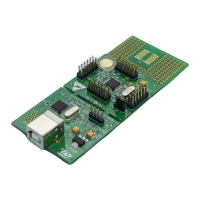Clock control (CLK) RM0016
80/449 Doc ID 14587 Rev 8
External crystal/ceramic resonator (HSE crystal)
The 1 to 24 MHz external oscillator has the advantage of producing a very accurate rate on
the main clock with 50% duty cycle.
The associated hardware configuration is shown in Figure 21. Refer to the electrical
characteristics section for more details.
At start up the clock signal produced by the oscillator is not stable, and by default a delay of
2048 osc cycles is inserted before the clock signal is released. You can program a shorter
stabilization time in the HSECNT option byte, please refer to option bytes section in the
datasheet.
The HSERDY flag in the External clock register (CLK_ECKR) indicates if the high-speed
external oscillator is stable or not. At startup, the clock is not released until this bit is set by
hardware.
The HSE Crystal can be switched on and off using the HSEEN bit in the External clock
register (CLK_ECKR).
External source (HSE user-ext)
In this mode, an external clock source must be provided. It can have a frequency of up to
24 MHz. You select this mode by programming the EXTCLK option bit. Refer to the option
bytes section of the datasheet. The external clock signal (square, sinus or triangle) with
~50% duty cycle has to drive the OSCIN pin while the OSCOUT pin is available as standard
I/O (see Figure 20).
Note: For clock frequencies above 16 MHz, Flash /data EEPROM access must be configured for 1
wait state. This is enabled by the device option byte. Refer to the datasheet option byte
section.
9.1.2 HSI
The HSI clock signal is generated from an internal 16 MHz RC oscillator together with a
programmable divider (factor 1 to 8). This is programmed in the Clock divider register
(CLK_CKDIVR).
Note: At startup the master clock source is automatically selected as HSI RC clock output divided
by 8 (f
HSI
/8).
The HSI RC oscillator has the advantage of providing a 16 MHz master clock source with
50% duty cycle at low cost (no external components). It also has a faster startup time than
the HSE crystal oscillator however, even with calibration the frequency is less accurate than
an external crystal oscillator or ceramic resonator.
The HSIRDY flag in the Internal clock register (CLK_ICKR) indicates if the HSI RC is stable
or not. At startup, the HSI RC output clock is not released until this bit is set by hardware.
The HSI RC can be switched on and off using the HSIEN bit in the Internal clock register
(CLK_ICKR).
Backup source
The HSI/8 signal can also be used as a backup source (Auxiliary clock) if the HSE crystal
oscillator fails. Refer to Section 9.6: Clock security system (CSS).

